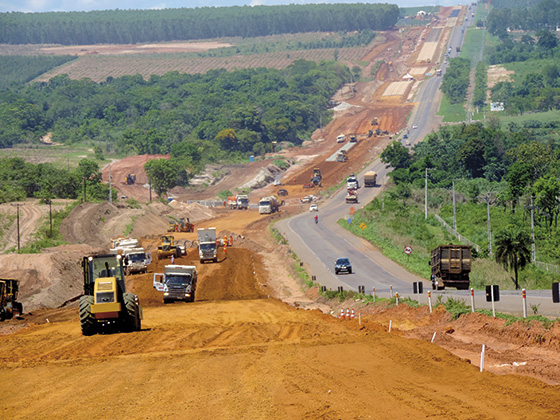Fleets improve the integration route in the state of MT

A section of the BR-163—the main connecting road between Northern and Southern regions—is receiving a second runway. Currently, this is the largest road work carried out in the country
In one of the main roads of the country—that connects the states of Rio Grande do Sul and Pará and that cuts the country’s territory through almost 3500 km—a huge fleet of heavy equipment works hard to fit a large section of the BR-163 to the current times.
The question is not to pioneer an inhospitable area with isolated indians of the Kreen-akarore community, with no contact with “white men”. This is really a good thing because we have no more the Villas-Boas brothers to contact these descendents of the fierce Cayapós and to allow the development of the oad opening works, as occurred far in the 70s.
In fact, times changed. Since then, the state of Mato Grosso became modern and is currently an important component of Brazilian economy of agricultural commodities, mainly soy beans. A section 850 km long of the road BR-163 cuts the entire state and has the main logistic function of offloading the grain production to the Northern region, crossing the Center-western region.
A total of R$ 5.5 billion was invested in the reconstruction and improvement of the road that will have two lanes in each direction. This is the first large intervention in the road since its construction, ended in 1976, during the military government, as part of the Plan of National Integration (PIN). At the end of the works, the road will have two runways and will have its pavement refurbished in the entire extension that crosses the state.
WESTERN ROUTE
From that total, R$ 2.6 billion will be spent till 2019. The company responsible for this challenge is the concessionaire Rota do Oeste, a company of the now-named Odebrecht Mobilidade, that replaced Odebrecht TransPort after the creation of a joint venture with the Japanese group Mitsui. The remaining R$ 2.9 billion will be spent along the operation of the concession during a period of 30 years.
The concessionaire will carry out works in 450 km of the road. The remaining 400 km that compose the BR-163 in Mato Grosso are under responsibility of the Departamento Nacional de Infraestrutura de Transporte (DNIT) that also intends to carry out improvements and works in these sections.
Rota do Oeste won the auction to manage the road presenting the lowest toll rate. The toll income will pay all costs that the concessionaire will spent with road construction and maintenance and will start to be charged when 10 percent of the works are concluded, what is foreseen for the second half of 2015.
Currently, Rota do Oeste is working in the first sections to be doubled, waiting for the operational and environmental licenses to go ahead in new fronts from this year on. “And when works start, our goal is to double and refurbish an average of 100 km per year, what means a very challenging schedule”, says Danilo Ribeiro, director of contracts of Odebrecht Infraestrutura (company of the group that will carry out the works of road improvement). M&T magazine visited parts of the works, especially the sections already concluded, seeing the huge work that has to be done.
RECYCLERS
To attend the schedules, the concessionaire will use—in the peak of works—567 machines of 36 different types, not considering the fleet made available by Odebrecht Infraestrutura and some specific rented equipment. “We are investing R$ 50 million in asphalt production and paving equipment”, says Cláudio Marquetti, company’s equipment manager, pointing out that two recyclers—imported from Germany—consumed a large part of this huge investment in new machines.
Manufactured by Wirtgen, these machines are being considered essential to ensure a better dynamics for paving the new runways that will be built and for the asphalt rebuilding of the existing runways. “This equipment crushes the laterite and the old asphalt, mixing and homogenizing the material and turning the soil appropriate for compaction”, explains Ribeiro. “These processes are carried out at a speed of 10 kilometers per hour, what is very significant for work progress.”
According to him, this technology was chosen to solve a technical deadlock that came out when establishing the composition of pavement base and sub-base. “Instead of the recycler, we tested soil plants before. In this situation, plants were located in two fixed points of the works and we fed them with a mix of laterite and cement in the ideal moisture content”, says Ribeiro. “Then the mixture would be transported to the work front and compacted using a paver.”
The process would include the supply of laterite by trucks coming directly from the reservoir. The plant would process the mixture and the truck would be used to transport the mixed material to the work front, what means a very complex cycle. “With the recycling machine we broke this cycle bringing the material directly to the work front and eliminating also the use of the paver in this phase”, says the expert.
“In addition, the recycler was even more efficient in processing because the laterite was difficult to mix to the other components due to its irregular grain size.”
ASPHALT
But there are also other highlights such as two asphalt plants manufactured by Lintec and imported from Germany. “They were imported because equipment with production capacity of 240 tons per hour and with gravimetric technology are not produced in Brazil”, says Ribeiro.
According to the manufacturer, this type of asphalt plant has a double-selection drum where the material is dried and classified in a single pass, passing through the drying drum in counterflow. Heated aggregates fall through openings located in the drum’s wall and go to the sieves, where they are classified and sent to the hot boxes without loss of heat in the process.
In this type of plant, only the cold material is transported to the top of the equipment through conveyors. Hot materials follow a natural flow from top to bottom, ensuring the ideal gravimetric balance to the process. Other types of plants with gravimetric concept need a bucket elevator for hot material, what leads to an energy consumption up to 10 percent higher in the production of asphalt.
Two Telsmith crushing plants, each one with capacity of 210 tons per hour are also integrated to the asphalt production equipment, to supply all aggregates needed to produce the asphalt mix that will be used in the works.
With this fleet, Odebrecht Infraestrutura is prepared to ensure large production volumes and to attend the schedule of doubling 100 km of road runways per year. To ensure these figures, logistics were also thoroughly studied by the company, in a way to prevent risks in the operation.

Av. Francisco Matarazzo, 404 Cj. 701/703 Água Branca - CEP 05001-000 São Paulo/SP
Telefone (11) 3662-4159
© Sobratema. A reprodução do conteúdo total ou parcial é autorizada, desde que citada a fonte. Política de privacidade














